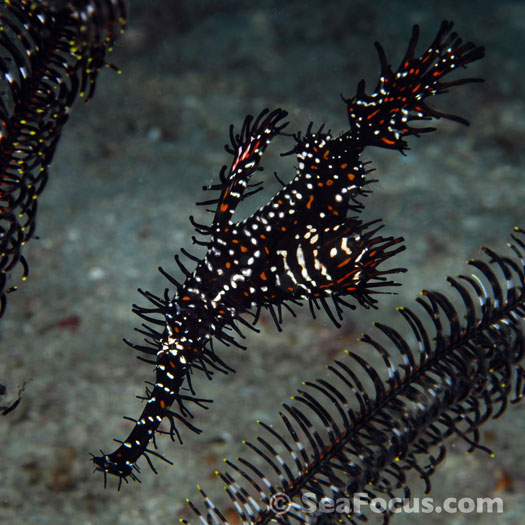|
|
PIPEFISH and GHOST PIPEFISH
|
| Underwater photography: images of pipefish taken while scuba diving |
| Cleaner pipefish | Ringed pipefish | Ornate ghost pipefish | Robust ghost pipefish | Thin ghost pipefish |
| Class: Actinopterygii Order: Syngnathiformes |
|
PIPEFISH
Family: Syngnathidae – seahorses and true pipefishes
Subfamily: Syngnathinae
GHOST PIPEFISH
Family: Solenostomidae – false and ghost pipefishes and tubemouth fishes
Genus: Solenostomus
|
|
The basic characteristics of all pipefish are much the same: their bodies are long and thin, they have a snout ending in a narrow mouth, a dorsal fin but no ventral fins. The existance of other fins all depends on which pipefish you look at. Most measure under 15 centimetres long, with ghost pipefish ranging between 7-15 cm. A few true pipefish will reach over 30 cm.
When it comes to courtship and reproduction, pipefish behave much like their seahorse relatives. After an energetic courtship dance, the female deposits her eggs onto the male. Some species have developed a patch of spongy skin for the eggs to stick to but others have a pouch to carry the eggs. The male then becomes completely responsible for the youngsters until they hatch. While this closely reflects seahorse behaviour, monogamy varies with peipefish – some are monogamous and others aren't.
Although closely related to seahorses and pipefish, ghost pipefish reproduction is more typical – the female carries the brood in the pouch formed by her modified pelvic fins. Ghosties are also site specific. Because they have the ability to adapt to match their surroundings they find it easy to blend into wherever they are. And once they have picked a nice pink fan and turned pink, or a nice hairy bit of algae and gone all hairy, you are likely to find them in the same spot day after day.
|
| All pipefish are members of the scientific class, Syngnathiformes, which includes seahorses, pipehorses and seadragons. The Latin name means fused or joined jaw.
There are a bewildering number of genera and species with ongoing research continually adjusting the opinions of what is what. Hence, this review is based on what we have personally seen.
|
|
|
|
|
Pipefish
image gallery
|
| click any image to enlarge |
Int. = intermediate stage
Juv.= juvenile |
|
|
| Pipefish |
|
|
|
|
|
|
|
|
|
|
|
|
|
|
|
|
|
|
|
|
|
|
Orange-banded pipefish
|
White-nose pipefish
|
Cleaner pipefish
|
Ringed pipefish with eggs
|
Ringed pipefish
|
Mushroom-coral pipefish
|
Orange-spotted pipefish
|
|
|
|
|
|
|
|
|
|
|
|
|
|
|
|
|
|
Slender
pipefish
|
Black-breasted pipefish
|
Network
pipefish
|
Harlequin
pipefish
|
Slender
pipefish
|
Messmate
pipefish
|
Winged pipefish
|
|
|
|
|
|
|
|
| Ghost pipefish |
|
|
|
|
|
|
|
|
|
|
|
|
 |
 |
 |
 |
 |
 |
 |
| Ornate ghost pipefish, female |
Ornate ghost mating pair |
Ornate ghost pipefish male |
Ornate ghost pipefish, juv. |
Rough-snout juv. (TBC) |
Robust ghost pipefish |
Thin ghost pipefish |
 |
 |
 |
 |
 |
 |
 |
| Robust/rough-snout ghost |
Ornate ghost pipefish |
Robust ghost pipefish |
Ornate ghost mating pair |
Robust ghost pipefish |
Delicate ghost pipefish, juv. |
Ornate ghost pipefish |
|
|
|
|
|
|
|
|
|
|
The IUCN Red List notes that there is insufficient data to assess the status of pipefish species
|
|
Pipefish encounters
|
| LOCATION: |
Philippines
|
| DIVE SITE: |
| Sabang Bay |
| DEPTH: |
22 metres
|
| SPECIES: |
| Solenostomus paradoxus |
| COMMON NAME: |
| Harlequin or (Ornate) ghost pipefish |
|
|
|
|
|
|
|
DIVE LOG:
A very long time ago we were in Thailand on a reef called Hin Muang. It was dreadfully pretty, an intense array of colours and tones. Staring at one place for a long time was a bit like those picture puzzles... squint for long enough and a dolphin appears. Only in this case, my eyes settled on this rather hairy creature just a couple of inches long. Getting closer we looked and frowned, What was it?
We snapped a couple of frames then later described it to our divemaster. We all decided it must have been a seahorse of some sort except it was upside down and hairy.
OK, OK. We were young, green and had no ID book with us. Several years later, we realised the weird creature had been an ornate ghost pipefish.
Since those days, no matter where we go. we have learnt to stare long and hard at soft corals and crinoids as that's where ornate ghosties hide the most.
|
 |
|
|
|
|
|
| SPECIES NAMES | Many fish can be hard to identify as they are so similar. Common names vary and even scientists disagree on what is what. If you can name anything we can't, please get in touch.
ORDER | Images on this page are available to buy as prints. Take a note of the name then go to the
photo order form...
SEARCH SeaFocus | Looking for something on this site? Type in a few words below...
|
|
|
|
|
|

